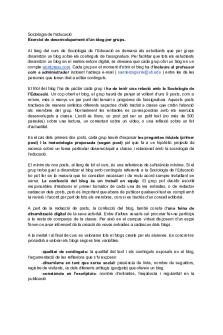Funnel web spider blog - 15/15 PDF

| Title | Funnel web spider blog - 15/15 |
|---|---|
| Course | Pharmacology 1 |
| Institution | University of Technology Sydney |
| Pages | 3 |
| File Size | 285.3 KB |
| File Type | |
| Total Downloads | 11 |
| Total Views | 133 |
Summary
15/15...
Description
Australia is Home to One of the Most Dangerous Killers How the Australian funnel web spider is one of the most deadly spiders in the WORLD What are these terrifying spiders? There are around 40 species of funnel web spiders and there are two main types – Hadronyche and Atrax. The Atrax robustus , or more commonly known as the Sydney funnel web spider, is the most toxic and associated with the most human deaths[3]. They range from medium to large in size, around 1-5 cm. They are either black or brown in colour and if threatened, aggressive behaviours will be shown by rearing on their back legs and putting on show their impressive, yet frightening, fangs (pictured below).
Rain can easily flood these funnel shaped burrows, causing the funnel web spider to retreat. They hate dry conditions as they are very susceptible to drying out, thus high humidity being forever in their favour.
What toxins do they produce? The main toxic element of venom in the Atrax and Hadronyche species is δ-atracotoxin and versutoxin[1]. They significantly affect the nervous system by inhibiting voltage-gated sodium channels[4]. This is detrimental because sodium channels rapidly communicate impulses through cells, allowing the body to coordinate movement and cognition[4]. These toxins cause many symptoms such as hypertension, muscle spasms, increased salivation, sweating, twitching of the tongue, and difficulty breathing[2].
What is envenomation? A threatened funnel web spider displaying its aggressive stance (photographed at the Australian Reptile Park, 2006)
Where are they found? Funnel webs of the Atrax type are found in a much smaller region than the Hadronyche type. The Sydney funnel web is found along the east coast, from as north as Newcastle, all the way down to Nowra[5]. They absolutely love living in cool, moist, and sheltered areas, such as under rocks and under wet logs. Funnel web spiders actually get their name from how they build their burrow. They build it in a, unsurprisingly, funnel shape with silk covering all around the entrance to capture prey (pictured below).
A funnel web spider burrow (photographed by Ramon Mascord)
Envenomation is when venom is injected into a person’s body through a sting or bite. There are two types of poisoning due to envenomation – localised and systemic. Localised poisoning only affects the area where the bite/sting has occurred. Systemic poisoning affects the entire body, creating autonomic, cardiovascular, and neurological problems[3].
What do I do if I get bitten? For a funnel web spider envenomation, the first aid treatment begins with cleaning the bite area with soap and water, and then immediately using the pressure immobilisation technique (pictured below). This technique involves wrapping the bite mark in a highly compressed bandage and then wrapping as much of the limb as possible. This is vital as it inhibits the venom from spreading and reaching the bloodstream[3]. Finally, splint the limb and joints either side of the bite to restrict movement. The victim must stay as still as a statue to ensure the venom does not spread. Medical attention must be called as soon as possible. Once the victim is at the hospital, they can be examined, and administered the antivenom. Christina Awad (13517533)
Diagram of the Pressure Immobilisation Technique
What is antivenom? Antivenom is the medication used to treat venomous bites and stings. It works by boosting the immune system and producing very strong antibodies to eliminate the toxins. It is made by obtaining venom from many different species. Then, very small doses of the venom are injected into animals, such as horses, rabbits or sheep, until the animal produces antibodies to the venom[3]. Once this has occurred, the blood is taken from these animals and the antibodies are separated out. The antibodies are purified through many steps of digestion and processing, finally being made into antivenom.
Did you know? Funnel web spiders can't swim but they can trap small bubbles of air in the hairs of their abdomen, which helps them to stay afloat and breathing. They can stay alive for hours in a swimming pool, so watch out the next time you go in for a dip!
Antivenom for Funnel Web Spiders In 1981, Dr Struan Sutherland and his team developed the first antivenom for the Sydney funnel web spider, Atrax robustus. Prior to this, there was 13 reported cases of deaths due to the funnel web spider. However, since the creation of the antivenom, there have been no deaths recorded[5].
Administering the antivenom Antivenom should be administered at the earliest sign of systemic envenomation[3]. If the patient shows these signs, inject the antivenom, and admit them into the ICU for careful monitoring for the next 12-24 hours. This is to ensure the antivenom is working and all the symptoms of the envenomation are gone. Observation is also very important because there can be side effects to the antivenom. These include an increased risk of an allergic reaction, shallow breathing, weak pulse, dizziness, fever, and swelling. If the patient only shows signs for localised envenomation, do not administer antivenom. Monitor for the next 4-6 hours to ensure the symptoms do not worsen.
Christina Awad (13517533)
References [1] Alewood, D., Birinyi-Strachan, L.C., Pallaghy, P.K., Norton, R.S., Nicholson, G.M. & Alewood, P.F. 2003, ‘Synthesis and characterization of delta-atracotoxin-Ar1a, the lethal neurotoxin from venom of the Sydney funnel-web spider (Atrax robustus)’, Biochemistry, vol. 42, no. 44, pp. 12933–40. [2] Del Brutto, O.H. 2013, ‘Neurological effects of venomous bites and stings: snakes, spiders, and scorpions’, Handbook of Clinical Neurology, vol. 114, pp. 349–68. [3] Isbister, G.K., Gray, M.R., Balit, C.R., Raven, R.J., Stokes, B.J., Porges, K., Tankel, A.S., Turner, E., White, J. & Fisher, M.M. 2005, ‘Funnel-web spider bite: a systematic review of recorded clinical cases’, Medical Journal of Australia, vol. 182, no. 8, pp. 407–11. [4] Marban, E., Yamagishi, T. & Tomaselli, G.F. 1998, ‘Structure and function of voltage-gated sodium channels’, The Journal of Physiology, vol. 508, no. Pt 3, pp. 647–57. [5] News, O.H.C. to the public until S. 2020 A. 1 W.S.N. 2010 A.P. +61 2 9320 6000 www australianmuseum net au C.© 2020 T.A.M.A. 85 407 224 698 V.M. n.d., ‘Funnel-web Spiders’, The Australian Museum, viewed 14 May 2020, .
Images News, O.H.C. to the public until S. 2020 A. 1 W.S.N. 2010 A.P. +61 2 9320 6000 www australianmuseum net au C.© 2020 T.A.M.A. 85 407 224 698 V.M. n.d., ‘Funnel-web Spiders’, The Australian Museum, viewed 14 May 2020, . News & World 2017, Zoo to Australians: Please help us catch deadly funnel-web spiders, we’re running short | National Post, viewed 14 May 2020, . PIB n.d., viewed 14 May 2020, .
Christina Awad (13517533)...
Similar Free PDFs

Funnel web spider blog - 15/15
- 3 Pages

Riassunto Biondino Spider Rossa
- 15 Pages

BLOG 1 - BLOG
- 3 Pages

Evidence Blog Pet peeves blog
- 1 Pages

PICO Spider Spice Eclipse
- 5 Pages

12min Blog
- 4 Pages

Exercici blog
- 2 Pages

Week5 - blog
- 6 Pages

Discussion Blog
- 1 Pages

Spider Lab Report - Grade: B-
- 4 Pages

Web - taller web
- 4 Pages

Spanish blog - Grade: A
- 1 Pages

Blog actividad 3 sena
- 2 Pages
Popular Institutions
- Tinajero National High School - Annex
- Politeknik Caltex Riau
- Yokohama City University
- SGT University
- University of Al-Qadisiyah
- Divine Word College of Vigan
- Techniek College Rotterdam
- Universidade de Santiago
- Universiti Teknologi MARA Cawangan Johor Kampus Pasir Gudang
- Poltekkes Kemenkes Yogyakarta
- Baguio City National High School
- Colegio san marcos
- preparatoria uno
- Centro de Bachillerato Tecnológico Industrial y de Servicios No. 107
- Dalian Maritime University
- Quang Trung Secondary School
- Colegio Tecnológico en Informática
- Corporación Regional de Educación Superior
- Grupo CEDVA
- Dar Al Uloom University
- Centro de Estudios Preuniversitarios de la Universidad Nacional de Ingeniería
- 上智大学
- Aakash International School, Nuna Majara
- San Felipe Neri Catholic School
- Kang Chiao International School - New Taipei City
- Misamis Occidental National High School
- Institución Educativa Escuela Normal Juan Ladrilleros
- Kolehiyo ng Pantukan
- Batanes State College
- Instituto Continental
- Sekolah Menengah Kejuruan Kesehatan Kaltara (Tarakan)
- Colegio de La Inmaculada Concepcion - Cebu


